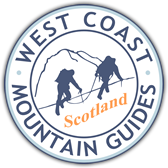Please indicate which items you may need to borrow before arriving. This can be done on the booking form.
We will arrange this prior to your arrival, depending on where you will be based. All courses include all equipment and will be stated on the course information, but if you are not sure, just ask.
We can arrange the use of the following
- Harness
- Climbing Helmet
- Ice Axe from
- Crampons from
Winter boots can be hired locally (from Nevisport, Ellis Brighams or Cotswold Outdoors) in Fort William, it is recommended that you book these well in advance as demand can be high during peak season (mid-Jan to mid-March, particularly weekends).
Recommended Kit List
Kit Ideally in a 35-45ltr Rucksack
Rucsac –A medium volume sac (30 -45 litres) is best for winter walking, with ice axe carrying loops. Use a strong plastic rucsac liner to keep the contents dry. External Rucsack covers have a habit of blowing away and don’t work as well as an internal liner. Everything needs to fit inside your sac.
Bivvy Bag –A large person sized poly or foil survival bag is the minimum requirement, essential.
Meals –Lunch, snacks and spare food.
Waterbottle –1 to 2 litres.
Flask –0.5-1 litre for hot drinks on the hill. If you take a flask, a waterbottle is optional. Don’t carry too much liquid in winter!
Head Torch – Essential for all courses, plus spare batteries.
Insulated jakcet – Down jacket or synthetic/primaloft for emergencies
Ski Goggles & Sunglasses – Some form of eye proctection is needed for the different conditions from sun light refacting of snow to snow blowing in your eye.
First Aid kit & Whistle –A small personal pack including medication for blisters. Suncream and sunglasses if good forecast.
Compass/Map/Watch –(OS sheet 41 & 34- 1:50 000 or BMC/Harveys Ben Nevis & Glencoe 1:40 000)
The map should be weather-proofed in a clear plastic map case or covered with clear sticky back plastic.
Gloves – Bring lots of gloves – I often carry a thin pair for walking in, 2x mid weight pairs for the days work and 1 extra large pair for emergencies.
Regular scrambling kit on your body
Socks –Go for a medium to thick pair of synthetic or wool/synthetic blend socks (no need for spares)
Boots – For winter hillwalking and skills courses, stiff, crampon compatible boots are required. They should have a stiffness rating of B1 minimum, and ideally B2. B3 boots are fine, so long as you find them comfortable.
Gaiters or Stop-tous –Essential for all courses.
Long Sleeve Thermal/Base Layers –A thermal or wicking top is far better than cotton.
Midlayer Synthetic or Fleeces –At least one mid layer for your upper body. If you get cold easily perhaps add a fleece gilet/vest to your layering. Having an extra fleece top or synthetic layer in a waterproof liner at the bottom of your rucksack is useful for the bivi in the evening.
Windshirt or lightweight softshell jacket –Ideal for dry conditions.
Walking trousers –Polycotton, polyester or softshell is ideal.
Warm Hat & Gloves – Bring lots of gloves – I often carry a thin pair for walking in, 2x mid weight pairs for the days work and 1 extra large pair for emergencies.
Waterproof jacket and over trousers ( Outer shell clothing) –The trousers should have at least a knee length zip enabling them to be fitted over boots. Lightweight waterproofs are ok.
Trekking Poles -These are optional, but useful particularly in descent. To keep weight down, consider taking only one, that can be either compressed or collapsed to fit inside your pack when not in use.
Climbing Equipment (We can supply all items below)
Crampons –Should have 10 or 12 points and be compatible with your boots. Clip-on heel crampons and front straps are very easy to fit on most modern B2 and B3 boots, whilst older traditional strap-on crampons are okay, but less easy to fit in cold windy conditions. We recommend anti-balling plates and cutting your straps to a suitable length (Not too short!). Ask for advice if you are unsure.
Ice Axe –For walking or general mountaineering an axe of 50 – 65cm is adequate. Whether you choose to have a wrist loop or leash is up to you, we recommend going without as they can get in the way.
Helmet –Required for winter skills & summits courses, not necessarily required for guided winter hillwalks. Please check.


